|
|
| RHP |
South African
River Health Programme
|
State of the Rivers Report
uMngeni River and Neighbouring Rivers and Streams
|
|
Below Nagle Dam, the uMngeni River is joined by the uMsunduze tributary and continues in an easterly direction. Towards Inanda Dam, increasing air temperatures and more unpredictable rainfall results in riparian grassland being partly replaced by indigenous tree and shrub thornveld dominated by indigenous acacias. Apart from farmlands around the uMsunduze, this resource unit is dominated by the rural Valley of a Thousand Hills, a vigorously undulating landscape with hills and valleys. A large rural population lives here, and many are directly dependent on the uMngeni River. The total population of the area is 152 000.
|
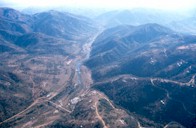
|
In the valley bushveld region, the uMsunduze River water quality is Poor, reflecting the impacts of the upstream city of Pietermaritzburg. The uMsunduze River thus reduces river health of the uMngeni River. Aquatic weeds flourish because of high nutrient levels, in particular in the uMsunduze River (see page 23).
The riparian zone of this river is in a Good condition despite intensive utilization in parts, especially in the lower reaches.
Instream habitat of the uMsunduze River is Fair. With the combination of poor water quality (caused primarily by excessive nutrients, toxic pollutants and high silt loads), the river habitat is unsuitable to the more delicate plants and animals. The instream habitat of the uMngeni River is in Good condition.
Invertebrates of the uMsunduze are in a Fair condition, reflecting the poor water quality coming from the city. The river is home to large numbers of hardy species such as benthic algae and midge larvae (Chironomids).
The fish in the area are fairly tolerant and have done well despite the poor water quality. Aliens include carp, bass and redbreast tilapia. Invertebrates and fish of the uMngeni River are in Good condition.
|
|
Water flow is affected by the dams upstream. Inanda Dam wall blocks fish migration. Some estuary species would have been present here but are now absent due to Inanda Dam wall.
In the area of the "Thousand Hills", the natural vegetation including that of the riparian zone has been much depleted during the 1900s as a result of over-utilization by a large local population. The area also suffers severe invasion by alien plants. The result is increased erosion and sedimentation of the river, and bank instability both of which reduce river health.
Excessive nutrients and pollution in the uMsunduzeRiver from The upstream city of Pietermaritzburg.
Overharvesting by subsistence fishermen.
Aquatic weeds are found throughout this resource unit, including water hyacinth, water lettuce, Kariba weed and parrots feather (see page 23)
Sand mining.
|
|
The instream purification of polluted water is a major service provided by the river, in particular the uMsunduze.
Supply of large amounts of good quality water via Inanda Dam to the city of Durban. Also extensive use of water by rural people for riparian agriculture and stock and game watering.
Sand mining from the river bed is an important activity in the middle reaches.
Scenic river environment and adequate river flow support a small but potentially much larger tourism industry. The river itself supports vibrant canoeing activity. Inanda Dam and Resources Reserve is only 45 minutes' drive from Durban and is an extremely popular site for jet skiing, power boating, yachting, fishing and self-guided hiking trails.
Riparian and wetland plants harvested for craft weaving, e.g. ikhwane and imizi.
Unfortunately this area has also lost valuable products - important indigenous medicinal plant species such as Siphonochilus aethopica and Stangeria eriopus have been eliminated.
|
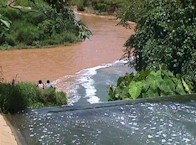
|
Manage flow releases from Nagle and Inanda dams to meet river-based needs downstream.
Consider the installation of eelways to allow juvenile migrating eels to climb the dam walls.
Minimise overgrazing and resultant sedimentation of the river.
Management of pollution and eutrophication, in particular of the uMsunduze River.
Control the spread of aquatic and terrestrial alien plants.
|
| RIVER AND SELF-PURIFICATION
|
|
|
Rivers have an extraordinary ability to purify themselves. Self-purification takes place as the water tumbles over rocks and sand, where huge numbers of invertebrates live together with a coating of microscopic algae, bacteria and other forms of life. These algae and bacteria absorb the nutrients and pollutants contained in the water. Some of the invertebrates in turn, feed on these organisms, while some bacteria convert toxic ammonia to less noxious forms. The activity of all these creatures scrubs, cleans and filters every millilitre of water, converting pollutants into animal and plant bodies, which in turn feed the next level on the food chain. These processes provide a service that is not visible and seldom appreciated. If rivers are abused to a point where these purification processes are damaged, the consequences for all users of the river could be extreme. The uMsunduze River is a prime example of a river where these processes play a very important purification role, producing a more acceptable water quality by the time it joins the uMngeni.
|
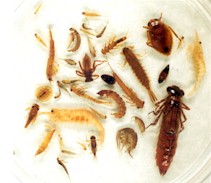
|
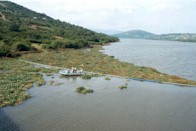
|
Within the uMngeni catchment, Inanda Dam and the uMngeni River upstream from the dam suffers the highest incidence of aquatic plant invasion.
Aquatic alien plants become problematic when their rampant spread is encouraged by excessive nutrients, particularly from urban runoff, sewage and agricultural fertilizers. The mild climate of KwaZulu-Natal also encourages rapid growth. Water hyacinth, water lettuce, Kariba weed, red water fern and parrot's feather have all been found at various places and times within the uMngeni and uMlazi rivers. These plants clog the water surface, deplete oxygen, foster mosquitoes, disrupt rivers' self-purification processes and may lead to a loss of aquatic species, with an associated loss in resource use and value. They also evapotranspire large volumes of water. Water supplied from water bodies covered with alien plants often requires sophisticated, expensive treatment.
|
|
Algal blooms develop when water nutrient levels are high enough to support rampant growth. The nutrients mainly responsible are phosphorous (mostly from detergents and fertilizer) and nitrogen (from sewage and fertilizer. One way to minimise problems associated with algal blooms is to maintain river health by preventing excess nutrients from entering rivers and thus dams.
|
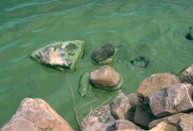
|
|
Algal blooms sometimes impart high costs to water consumers. The cost of removing just the taste and odour imparted by algae at times of a severe bloom (e.g. approximately once in 24 months on Nagle Dam), is significant. Millions of Rands worth of chemicals have to be kept at the water-works year round, just in case these algae get out of hand.
In the early 1990s Inanda Dam became a seething mass of noxious algae, largely due to the rotting vegetation and humus layer drowned by the rising waters. Since then the dam has stabilised and water quality has improved mainly due to upgrades by Umgeni Water at Darvill Wastewater works, that reduced the nutrient load from Pietermaritzburg.
Shongweni Dam (in the neighbouring uMlazi catchment) has also had severe problems, with the main cause being excessive nutrient inputs from Hammarsdale and Mpumalanga. Blooms of, at times toxic, blue-green algae have been common, making this dam unsuitable for domestic water supplies, and of questionable quality for recreation purposes.
|
|